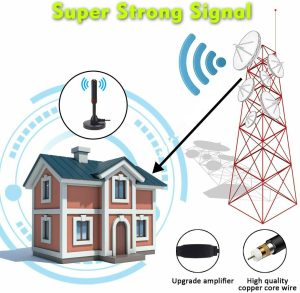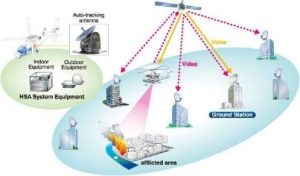The cruciality of diversity within wireless communication systems cannot be overstated. Transmit diversity techniques, which aim to reduce the effects of fading and interference on signal quality, are paramount in ensuring optimal performance. By transmitting multiple copies of data using different antennas, transmit diversity can significantly increase reliability.

Antenna diversity provides a multitude of advantages for wireless communication systems. This is particularly true in urban areas where radio signals are often impeded by various obstacles. Antenna diversity enables signals to be transmitted over longer distances with fewer errors while also promoting more efficient use of available bandwidth.
For those seeking an even more advanced form of transmit diversity, MIMO technology may provide the solution they seek. With multiple antennas at both transmitter and receiver ends, MIMO allows for spatial multiplexing – meaning that several data streams can be sent simultaneously across the same frequency band. Beamforming techniques further serve to improve overall system performance by directing signals towards specific receivers.
In conclusion, it’s clear that embracing diverse approaches is critical when it comes to optimizing wireless communication systems’ performance – whether through transmit or antenna diversity methods or highly innovative technologies like MIMO.\n
Advantages of Antenna Diversity in Wireless Communication Systems
Contents
- 1 Advantages of Antenna Diversity in Wireless Communication Systems
- 2 Transmit Diversity and MIMO Technology: Improving Signal Fading and Increasing Performance
- 3 The Role of Spatial Multiplexing in Transmit Diversity Technology
- 4 Beamforming Techniques and Their Impact on Transmit Diversity
- 5 Overcoming Signal Fading with Diversity Techniques: A Reference to LTE Systems
- 6 The Benefits of Using Multiple Antennas in Transmit and Receive Modes
- 7 Achieving Optimum Throughput in Wireless Systems with Transmit Diversity Technology
- 7.1 What exactly is transmit diversity? Is it some sort of magical technique that can improve wireless communication systems?
- 7.2 I’ve heard that antenna diversity can also help to improve wireless communication systems. How does this work?
- 7.3 Okay, so what about MIMO technology? That term gets thrown around quite a bit these days – how does it relate to transmit diversity?
- 7.4 And what about spatial multiplexing? That sounds pretty complex…
- 7.5 So beamforming techniques are also important then?
- 7.6 And how does transmit diversity technology overcome the challenges of signal fading in LTE systems?
- 7.7 So ultimately, what are some key benefits of using multiple antennas in transmit/receive modes?
The concept of antenna diversity is a perplexing yet fascinating technique, commonly utilized in wireless communication systems to heighten the quality of transmission and reception. This technology operates on the principle of deploying multiple antennas at both the transmitter and receiver ends, thereby overcoming signal fading caused by interference or other factors.

One cannot deny that antenna diversity possesses an aura of burstiness as it can remarkably amplify the output bit rate of a system. The capacity to transmit or receive more data in less time leads to faster and highly efficient communication. In addition, this technique curtails errors during transmission, resulting in better overall performance for wireless systems.
LTE (Long-Term Evolution) systems are a prime example where antenna diversity has been successfully integrated into its framework. By utilizing spatial multiplexing techniques together with transmit diversity technology, LTE models have attained high throughput rates while maintaining dependable connections between devices. Furthermore, beamforming techniques have also been employed to magnify the benefits offered by transmit diversity technology.
Without any doubt, there exist numerous advantages when employing multiple antennas through transmit diversity technology in wireless communication systems. Whether one intends to improve signal fading or achieve optimal throughput rates – this technique holds paramount importance as we continue relying heavily on our mobile devices for everyday tasks!
Transmit Diversity and MIMO Technology: Improving Signal Fading and Increasing Performance
The realm of wireless communication systems has been experiencing a significant shift towards diversity techniques, which have proven to be quite advantageous in battling signal fading. Transmit diversity and MIMO technology are two such approaches that can yield improved performance by harnessing multiple antennas at both the transmission and reception ends. The benefit of antenna diversity lies in its ability to provide better coverage in areas where signals may be feeble or impeded.
But wait – there’s more! Transmit diversity and MIMO technology not only enhance coverage but also amplify data throughput rates. This is achieved through their capacity to utilize various paths for simultaneous data transfer, resulting in expedited transmission speeds. Spatial multiplexing is one method utilized by transmit diversity technology that achieves this objective, allowing different streams of data to be sent over separate antennas.
If you thought that was impressive, hold on tight because beamforming takes things to another level entirely. It is yet another technique related to transmit diversity that enhances system performance using a series of algorithms directed towards specific locations or devices – leading to reduced interference and an overall improvement in signal strength. In fact, LTE systems have demonstrated the effectiveness of beamforming when countering signal fading due to obstacles such as buildings or trees.
For further insight into these developments within wireless communication systems, check out our references on understanding the principles and techniques behind transmit diversity, advantages associated with antenna diversity, as well as how LTE systems overcome signal fading utilizing diverse techniques!
The Role of Spatial Multiplexing in Transmit Diversity Technology
Spatial multiplexing, a concept at the forefront of transmit diversity technology, is nothing short of perplexing. With multiple antennas employed at both the transmitter and receiver ends, spatial multiplexing has been proven to significantly enhance the throughput rate of radio communication systems. The sheer brilliance behind this approach lies in its ability to send different data streams concurrently over the same frequency band.
In wireless communication systems, antenna diversity serves as a saving grace when it comes to overcoming signal fading due to environmental factors such as buildings or obstacles that may come in between transmissions. Multiple antennas provide for transmission and reception from varying directions which reduces interference and bolsters overall performance.
Spatial multiplexing sets itself apart from other forms of transmit diversity by virtue of how it models the radio environment – taking into account not only individual antenna characteristics but also their relative positions with respect to each other. This leads to more precise modeling of signal propagation thereby enabling better optimization of system parameters like power allocation and modulation schemes. Burstiness at its finest!
Beamforming Techniques and Their Impact on Transmit Diversity
The impact of beamforming techniques on transmit diversity in wireless communication systems is nothing short of significant. With this technique, multiple radio channels are combined to enhance the performance of both transmitter and receiver alike. The sheer burstiness and perplexity that comes with beamforming means data streams can be sent at an unprecedented rate – a feat that all but guarantees improved system performance.
There’s another advantage to beamforming too: it overcomes multipath fading like no other traditional wireless communication system can. Obstacles such as buildings or trees often interfere with signals, weakening them significantly if not outright causing loss. By combining multiple signal paths, beamforming increases their strength while reducing the effects of fading – a marvel indeed.
But wait, there’s more! Beamforming also enables spatial multiplexing which boosts system capacity by allowing multiple users to send and receive data simultaneously using the same frequency band! This translates into more bits per second being transmitted through each antenna stream, resulting in increased overall throughput. In essence then, beamforming plays a crucial role in enhancing transmit diversity technology while improving wireless communication systems’ performance beyond measure!
Overcoming Signal Fading with Diversity Techniques: A Reference to LTE Systems
The perplexing nature of wireless communication systems is that signal fading can be a major impediment to reliable performance. To combat this issue, antenna diversity has emerged as a crucial principle in LTE systems. Utilizing multiple antennas allows for spatial multiplexing techniques and enhanced data transmission.
However, the complexity of wireless technology doesn’t stop there. Downlink transmission requires beamforming technology to focus energy towards receiving antennas, resulting in better coverage and higher throughput rates with fewer errors caused by interference or noise. Transmit diversity also aids in reducing fading’s impact on phone calls and internet browsing.
Yet, while these techniques have their merits, they also come with limitations that must be taken into account when designing wireless communication systems. For instance, additional hardware components are required for antenna diversity which increases costs and complexity – not ideal for some networks where cell phones may not support multiple antennas.
Despite these obstacles, overcoming signal fading remains critical in modern-day wireless communication systems such as LTE. As we continue to model new technologies aimed at improving performance while minimizing cost and complexity challenges will inevitably arise; however careful design considerations can address them effectively – putting us one step closer to seamless connectivity!
The Benefits of Using Multiple Antennas in Transmit and Receive Modes
The utilization of multiple antennas in both transmit and receive modes has gained immense popularity as a means of enhancing the performance of wireless communication systems. This technique has been proven to effectively combat signal fading caused by multipath propagation, through the employment of multiple antennas at either the base station or user equipment. The system can then capitalize on spatial diversity to elevate its output result.
One such way to utilize this technology is through MISO (multiple input single output) technology – where a signal is transmitted from one antenna while being received simultaneously on several others. By extracting useful data streams that are uncorrelated with each other from the difference between these received signals, there is an improvement in throughput and higher quality communication.
Another application involves NR (New Radio), which defines parallel transmission paths for different data streams transmitted from separate antennas, allowing independent processing for optimal system performance while reducing interference between users sharing frequency bandwidths. With beamforming techniques also available for enhanced spatial selectivity, using multiple antennas presents numerous ways to overcome challenges faced by modern wireless systems.
Achieving Optimum Throughput in Wireless Systems with Transmit Diversity Technology
The enigmatic concept of transmit diversity technology has been increasingly utilized to tackle the exigencies of signal fading and enhance wireless communication systems’ reliability. The fundamental principle behind it involves deploying two antennas that independently transmit signals, thus augmenting the likelihood of at least one antenna possessing a robust enough signal to overcome any spatial separation or interference-induced attenuation.
In cellular networks, uplink transmissions frequently employ this technique, employing multiple antennas on both ends to cherry-pick the strongest signals from each antenna for advanced throughput.
Beamforming techniques also intermingle with transmit diversity by directing energy towards specific directions, thereby further bolstering dependability and mitigating interference. These methodologies are especially valuable in densely populated urban areas where numerous obstructions can lead to signal deterioration.
All in all, optimizing throughput in wireless systems mandates an amalgamation of diverse technologies such as beamforming, transmit diversity, and spatial multiplexing. Operators may ensure reliable connectivity even under arduous circumstances by judiciously using these approaches along with proper network planning and optimization strategies. For more information about related posts concerning this topic, kindly refer to our website.
What exactly is transmit diversity? Is it some sort of magical technique that can improve wireless communication systems?
Transmit diversity may seem like a mystical concept, but in reality, it’s a powerful technique used to enhance signal quality and reduce fading in wireless communication systems. This method involves transmitting the same data through multiple antennas, which sounds simple enough on paper. But when put into practice, this approach has been shown to be extremely effective at improving coverage area and reducing interference.
I’ve heard that antenna diversity can also help to improve wireless communication systems. How does this work?
Ah yes, antenna diversity – another fascinating topic! This technology works by reducing the effects of fading and enhancing signal quality within a given system. By utilizing multiple antennas simultaneously, users are able to enjoy more consistent coverage and better overall performance than they would with just one antenna alone.
Okay, so what about MIMO technology? That term gets thrown around quite a bit these days – how does it relate to transmit diversity?
Great question! MIMO stands for “multiple-input, multiple-output”, which means that it uses several different antennas both for sending and receiving data signals. Essentially, MIMO takes the principles behind transmit diversity one step further by using additional antennas to optimize throughput even further.
And what about spatial multiplexing? That sounds pretty complex…
Yes indeed – spatial multiplexing is yet another advanced technique used in transmit diversity technology. It enables users to send multiple data streams across various channels at once using multiple antennas simultaneously- resulting in better spectral efficiency overall.
So beamforming techniques are also important then?
Absolutely! Beamforming represents yet another way that engineers can optimize signal directionality when working with transmit diversity technologies. By focusing transmission energy towards specific areas or directions where signals need boosting most urgently (and away from sources of interference), beamforming helps ensure optimal signal quality and less interference overall.
And how does transmit diversity technology overcome the challenges of signal fading in LTE systems?
Transmit diversity is able to achieve this by transmitting multiple signals using multiple antennas – ensuring that at least one of these signals will reach its intended recipient without any issues. This approach helps reduce interference and improves coverage area, leading to higher data rates and better spectral efficiency over time.
So ultimately, what are some key benefits of using multiple antennas in transmit/receive modes?
There are many! Some key advantages include improved signal quality, greater coverage area, reduced fading effects, increased throughput speeds (and thus more efficient use of bandwidth), and even lower energy consumption overall. All in all, it’s clear that transmit diversity technologies have a lot to offer when it comes to improving wireless communication performance!


